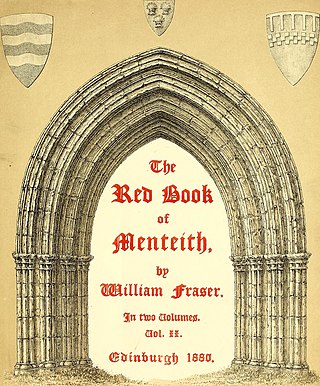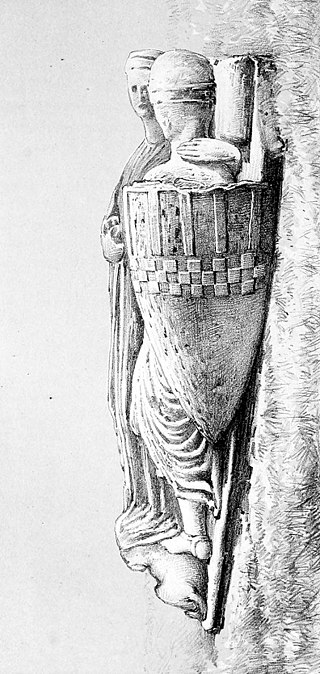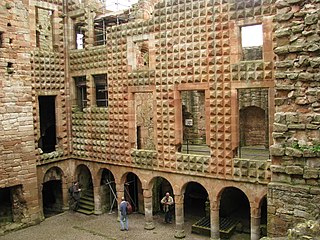
Robert Stewart, Duke of Albany was a member of the Scottish royal family who served as regent to three Scottish monarchs. A ruthless politician, Albany was widely regarded as having caused the murder of his nephew, the Duke of Rothesay, and brother to the future King James I of Scotland. James was held in captivity in England for eighteen years, during which time Albany served as regent in Scotland, king in all but name. He died in 1420 and was succeeded by his son, Murdoch Stewart, Duke of Albany, who was executed for treason when James returned to Scotland in 1425, almost causing the complete ruin of the Albany Stewarts.

The Mormaer or Earl of Menteith was the ruler of the province of Menteith in the Middle Ages. The first mormaer is usually regarded as Gille Críst, simply because he is the earliest on record. The title was held in a continuous line from Gille Críst until Muireadhach IV, although the male line was broken on two occasions. A truncated version of the earldom was given two years later to Malise Graham, 1st Earl of Menteith, in compensation for loss of the Earldom of Strathearn, which was a likely result of the execution of the Duke of Albany.

Agnes Randolph, Countess of Dunbar and March, known as Black Agnes for her dark complexion, was the wife of Patrick, 9th Earl of Dunbar and March. She is buried in the vault near Mordington House.
Robert of Strathearn was the 4th Earl of Strathearn in Scotland.

Malise IV of Strathearn was a Scottish nobleman, the seventh known ruler of Strathearn. He was an ardent supporter of King Robert the Bruce, in contrast to his father, Malise III, who sided with Edward I of England.
Donnchadh of Lennox was the Mormaer of Lennox, 1385–1425. He was a son of Baltar mac Amlaimh and Margaret, daughter of Domhnall, Earl of Lennox.
Thomas, Earl of Mar, was a 14th-century Earl of Mar, an earldom located in the County of Aberdeen, Scotland. He is sometimes styled Mormaer of Mar since mormaer was the Scottish Gaelic equivalent of the English word earl. Because the identification and numbering of the ancient earls of Mar is debatable, Thomas is variously numbered the ninth, tenth, or thirteenth. of the ancient earls. He was a son of Domhnall II of Mar, who fell at the Battle of Dupplin Moor in 1332.
Hugh [probably Gaelic: Aodh], was the third successor of Ferchar mac in tSagairt as Mormaer of Ross (1323–1333).
Walter Comyn, Lord of Badenoch was the son of William Comyn, Justiciar of Scotia and Mormaer or Earl of Buchan by right of his second wife.
Muireadhach III, Earl of Menteith was a Scottish nobleman.

Walter Bailloch, also known as Walter Bailloch Stewart, was distinguished by the sobriquet Bailloch or Balloch, a Gaelic nickname roughly translated as "the freckled". He was the Earl of Menteith jure uxoris.
Alexander of Menteith, a Scottish nobleman and member of the Stewart family, he was the Earl of Menteith.
Euphemia Stewart, Countess of Strathearn was a medieval Scottish noblewoman, the daughter of David Stewart, Earl Palatine of Strathearn and Caithness. She succeeded to both her father's titles after his death between 1385 and 1389, probably March 1386.
Malise Graham, 1st Earl of Menteith was a 15th-century Scottish magnate, who was the heir to the Scottish throne between 1437 and 1451, if Elizabeth Mure's children were not counted as lawful heirs.
Alan, Earl of Menteith was a Scottish nobleman.

Francis Stewart, 5th Earl of Bothwell was Commendator of Kelso Abbey and Coldingham Priory, a Privy Counsellor and Lord High Admiral of Scotland. He was a notorious conspirator, who led several uprisings against King James VI and died in poverty, in Italy, after being banished from Scotland. Francis was the first cousin of King James VI of Scotland. Francis's maternal uncle James Hepburn, 4th Earl of Bothwell was the chief suspect in the murder of James VI's father Henry Stuart, Lord Darnley.
William Graham, 3rd Earl of Menteith was a Scottish magnate and third Earl of Menteith.
Margaret Graham, Countess of Menteith was a Scottish noblewoman. She held the title Countess of Menteith in her own right, having inherited the title c. 1360 from her mother, Mary, Countess of Menteith, who was married to Sir John Graham. Graham was styled Earl of Menteith during his marriage with Mary, whom he predeceased. The Menteith region was situated partially in southwest Perthshire and partly in Stirlingshire.

Sir John Menteith of Ruskie and Knapdale was a Scottish nobleman during the Wars of Scottish Independence. He is known for his capture of Sir William Wallace in 1305 and later joined with King Robert I of Scotland and received large land grants in Knapdale and Kintyre for his service. He is described as "guardian" of the Earldom of Menteith, as his great-nephew Alan II, Earl of Menteith was a minor at the time of the death of Alan I, Earl of Menteith.
Alan II, Earl of Menteith was a Scottish Nobleman.






